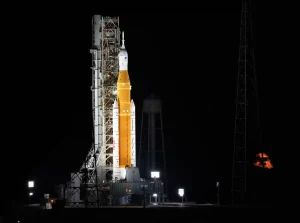The present successful launch of Artemis was preceded by two suspended attempts during the months of August and September because of technical issues
NASA’s Artemis 1, the most powerful space rocket, launches its debut flight from the Kennedy Space Center in Florida on Wednesday. The rocket will be advancing toward space with an astronaut-less Orion capsule around the moon and back. The spacecraft comprises the potent Space Launch System (SLS) and is set to travel a 1.3-million-mile journey spanning 25 days. This will be the first NASA first crew capable deep space mission in the past 50 years. The program is named after the Greek goddess of the moon Artemis and the twin sister of the sun god Apollo.
The 32-story tall Space Launch System carries three test dummies on board along with a soft toy estimating radiation levels and is capable of testing life preservation systems and equipment designed for long-duration human spaceflight. Artemis’ successful launch brought the space organization one step closer to the lunar dream for the second time after the Apollo mission in the year 1972.

The Artemis program is a crucial test for NASA as the space organization aims to put astronauts after five decades of drifting in low-earth orbit. The present successful launch of Artemis was preceded by two suspended attempts during the months of August and September because of technical issues. The launch director Charlie Blackwell-Thompson stated that the first launch of Artemis will also be the first step in returning the country to the moon and to Mars. “We are all part of something incredibly special,” says Charlie Blackwell-Thompson.
The culmination of the mission in the Pacific Ocean will be crucial to the succeeding mission Artemis 2 and 3 as both carry humans to and from the moon and are scheduled for the year 2025. Artemis 1’s is an international effort led by NASA along with the Japan Aerospace Exploration Agency (Jaxa), European Space Agency (Esa), and the Canadian Space Agency (CSA). NASA’s Associate Administrator for Science Thomas Zurbuchen says, “This is not about flags and footprints,” It’s about building a sustainable presence on the Moon and to set in place the foundations for a moon base and future missions to Mars”.
Untangling the Beyond
The mission brings new hope to the space administration agency to bring forward the unknown mysteries of the lunar craters and test the technological efficiency for the journey to Mars and provide a base for the future of space exploration. Orion is sent on a 26-day expedition that will take it into what’s called a distant retrograde orbit at the Moon. At its closest, the capsule will be 100km away from the lunar surface, and Orion will be up to 70,000km (45,000 miles). This will be the farthest away from Earth any human-rated spacecraft has ever ventured.
The next Artemis mission will take four astronauts on a journey around the moon but do not land on the surface and will launch in the year 2024. The Artemis 3 mission, which is currently scheduled for the year 2025 will have two astronauts landing near the moon’s south pole.
The $4.1 billion test flight has three mannequins which NASA calls the moonequins and are equipped with sensors to measure vibrations, cosmic radiation, and acceleration. The soft toy present in Orion will estimate the radiation levels and is capable of testing the life preservation systems. However, the launch occurred years behind schedule costing billions of dollars over budget. People behind are now concerned to learn that Orion’s heat shield will handle the extreme temperatures it will confront when it re-enters into the earth’s atmosphere. The capsule will be coming in at a speed of 38,000 km/h which is 32 times the speed of sound. NASA is currently in discussion with the rocket’s manufacturers for up to 20 more launches